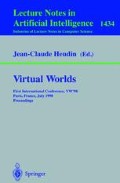Abstract
In this paper, we present the results of a human factor study aimed at comparing the effect of stereoscopic versus monoscopic viewing on human tracking performance. The experimental paradigm involved tracking and grasping gestures toward a 3D moving object. This experiment was performed using different frame rates (from 28 frames per second (fps) down to 1 fps). Results show that monoscopic viewing allowed stable performance (grasping completion time) down to 14 fps. Stereoscopic viewing extended this stabilty to 9 fps, and decrease task completion time by 50 % for frame rate under 7 fps. We observed that stereoscopic viewing did not much increase performance for high frame rates.
Access this chapter
Tax calculation will be finalised at checkout
Purchases are for personal use only
Preview
Unable to display preview. Download preview PDF.
References
A.P. Georgopoulos, J. Kalaska, and J. Massey, “Spatial trajectories and reaction times of aimed movement: effects of practise, uncertainty, and change in target location”, Journal of Neurophysiol., 46:725–743, 1981.
C.G. Atkeson and J. Hollenback, “Kinematic features of unrestrained vertical arm movement”, Journal of Neuroscience, 5:2318–2230, 1985.
J.A Thomson, ‘How do we use visual information to control locomotion ?” Trends in Neuroscienc es 3, 247–250, 1980
J.A Thomson, “Is continual visual monitoring necessary in visually guided locomotion ?” Journal of Experimental Psychology: Human perception and performance9, 427–443, 1983.
V. Ranadive, “Video Resolution, Frame-rate, and Grayscale Tradeoffs under Limited Banwidth for Undersea Teleoperation”, SM Thesis, M.I.T, September 1979.
M. Massinimo and T. Sheridan, “Variable force and visual feedback effects on teleoperator man/machine performance” Proceedings of NASA Conference on Space Telerobotics, Pasadena, CA. Vo.1, pp:89–98, January 1989.
Y.-Y. Yeh and L.D. Silberstein, “Spatial judgments with monoscopic and stereoscopic presentation of perspective displays.” Human Factors, 34(5), 583–600, 1992.
D. Regan, K.I. Beverley, “Some dynamic features of depth perception”, Vision Research, Vol:13, 2369–2379, 1973.
W.N. Kama and R. DuMars, “Remote Viewing: A Comparison of Direct Viewing, 2-D and 3-D Television, AMRL-TDR-64-15, Wright-Patterson Air-Force Base, 1964.
P. Rupert and D. Wurzburg “Illumination and Television Considerations in Teleoperator Systems”. Heer, E. (Ed.), Remotely Manned Systems, California: California Institute of Technology, pp. 219–228, 1973.
L.A. Freedman, W. Crooks and P. Coan, “TV Requirements for Manipulation in Space”. Mechanism and Machine Theory, 12,5, 425–438, 1977.
R.L Pepper, D. Smith and R. Cole, “Stereo TV Improves Operator Performance under Degraded Visibility Condition” Optics and Engineering 20,4, 579–585, 1981.
R.L. Pepper, R. Cole, E. Spain and J. Sigudson, “Reseach Issues Involved in Applying Stereoscopic Television to Remotelly Operated Vehicles” Proceedings of SPIE, 402-Three-Dimensional Imaging, 170–173, 1983.
S.R. Ellis, W. Kim, M. Tyler, M. McGreevy and L. Stark, “Visual Enhancement for Telerobotics: Perspective Parameter”. IEEE 1985 Proceedings of the International Conference on Cybernetics and Society, pp. 815–818, 1985.
W.S. Kim, S. Ellis, B. Hannaford, M. Tyler and L. Stark, “A Quantitative Evaluation of Perspective and Stereoscopic Display in Three-Axis Manual Tracking Tasks” IEEE Transportation Systems, Man and Cybernetics, SMC-17,1, pp. 16–72, 1987.
VPL Research Inc., “DataGlove model 2 Operating manual”, Redwood City, CA, 1987.
Polhemus Navigation Science Division, Space Isotrack User’s Manual, Colchester, VT. 1987.
Hewlett-Packard, “Starbase Display List Programmers Manual”, 1st Edition, January, 1991.
Author information
Authors and Affiliations
Editor information
Editors and Affiliations
Rights and permissions
Copyright information
© 1998 Springer-Verlag Berlin Heidelberg
About this paper
Cite this paper
Richard, P., Hareux, P., Coiffet, P., Burdea, G. (1998). Effect of Stereoscopic Viewing on Human Tracking Performance in Dynamic Virtual Environments. In: Heudin, JC. (eds) Virtual Worlds. VW 1998. Lecture Notes in Computer Science(), vol 1434. Springer, Berlin, Heidelberg. https://doi.org/10.1007/3-540-68686-X_9
Download citation
DOI: https://doi.org/10.1007/3-540-68686-X_9
Published:
Publisher Name: Springer, Berlin, Heidelberg
Print ISBN: 978-3-540-64780-5
Online ISBN: 978-3-540-68686-6
eBook Packages: Springer Book Archive

